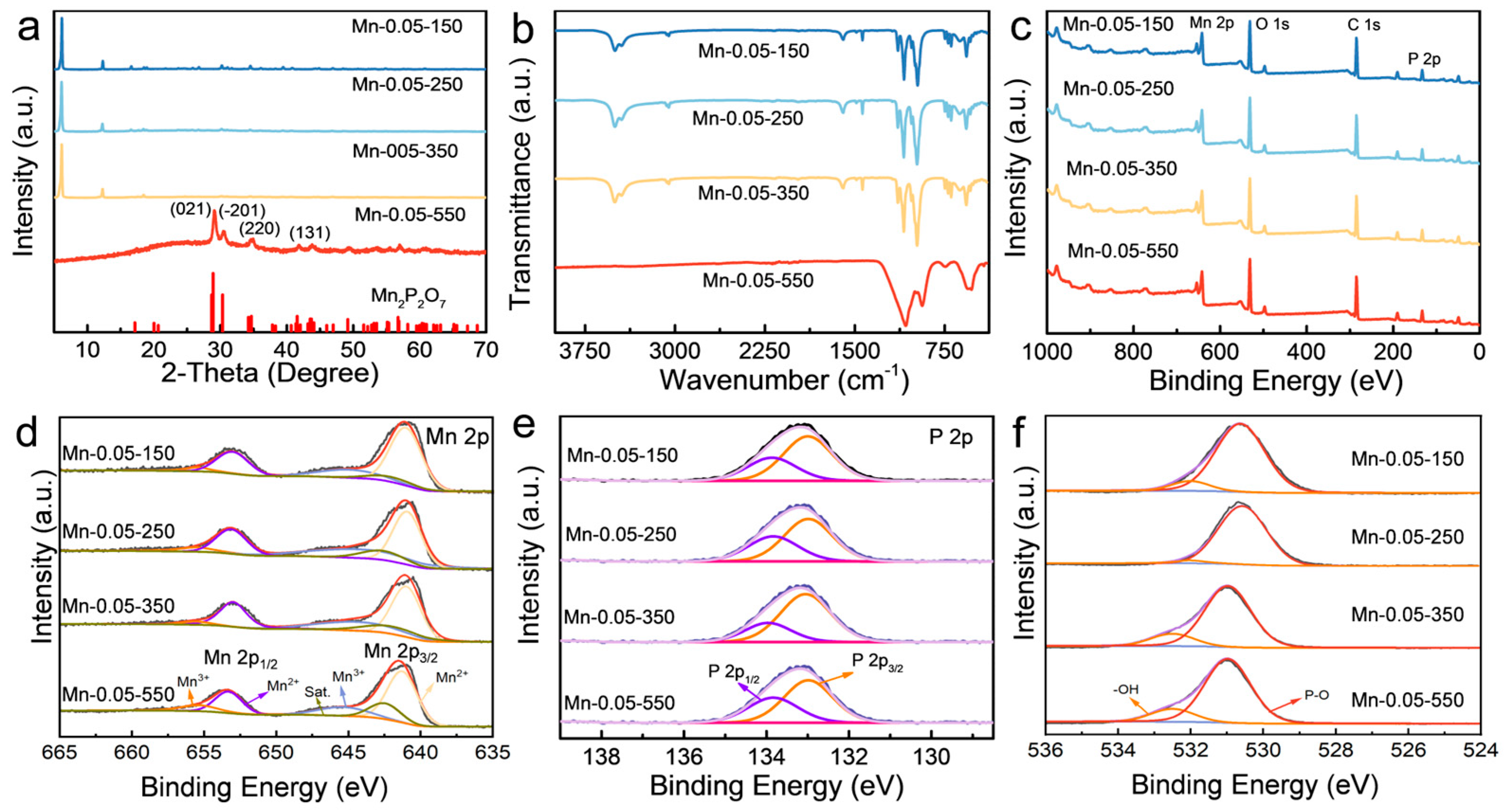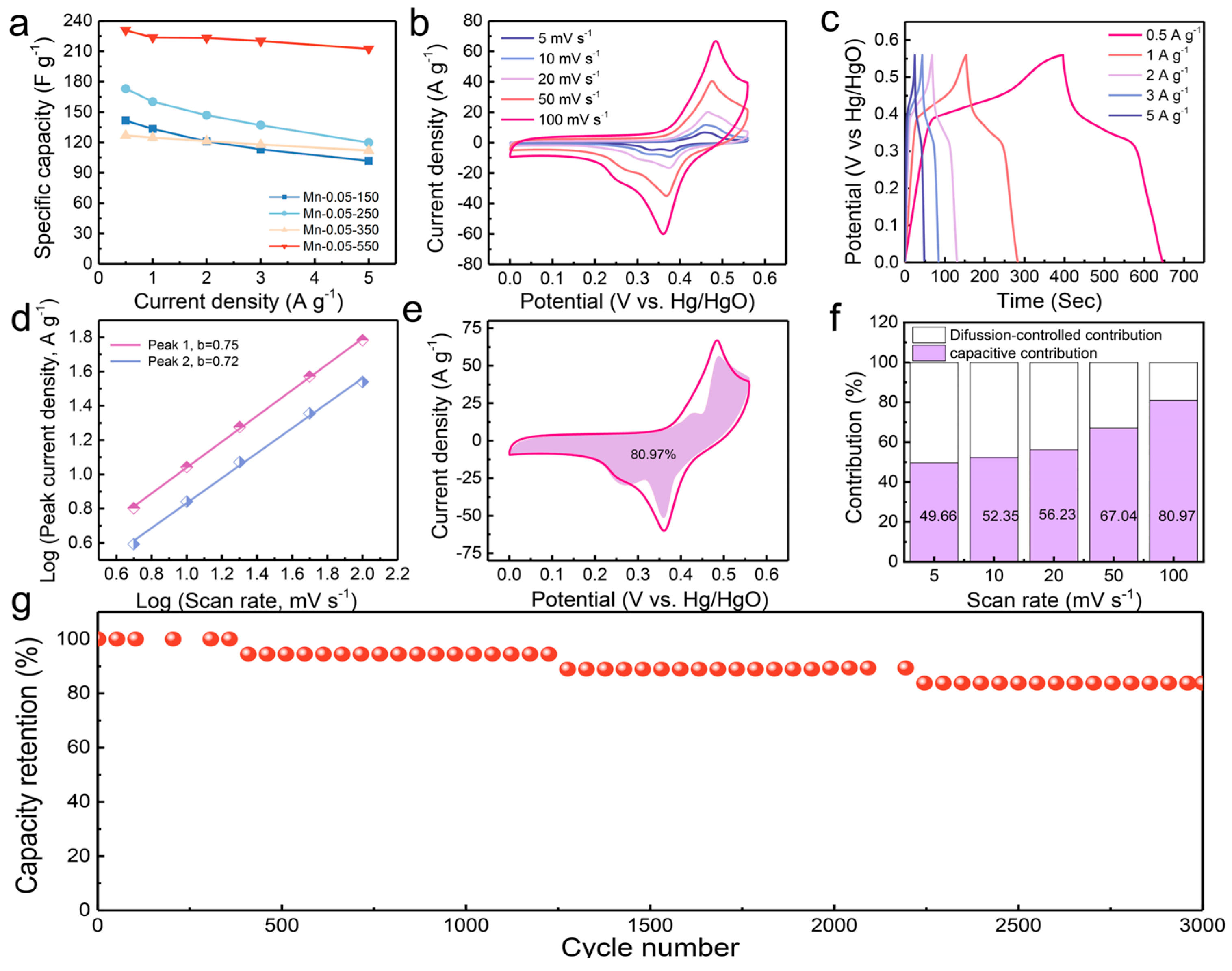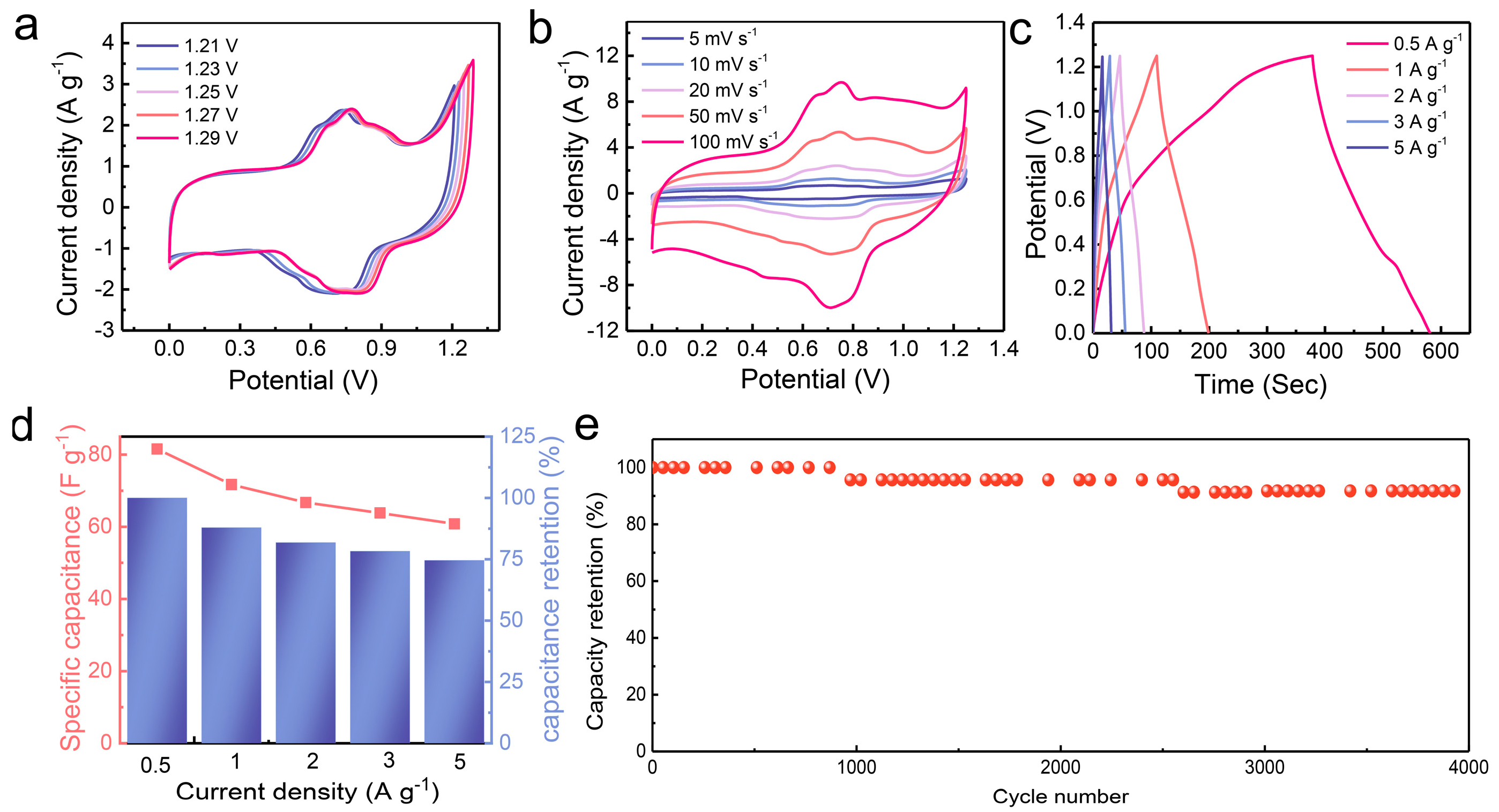Controllable Synthesis of Manganese Organic Phosphate with Different Morphologies and Their Derivatives for Supercapacitors
Abstract
:1. Introduction
2. Results and Discussion
2.1. Morphological and Structural Analysis
2.2. Electrochemical Performance Studies
3. Materials and Methods
3.1. Materials
3.2. Materials Synthesis
3.2.1. Synthesis of Mn-DMF-0.15
3.2.2. Synthesis of Mn-DMF-0.05
3.2.3. Synthesis of Mn-DMF-0.2
3.2.4. Preparation of Mn-0.05-X
3.3. Material Characterization
3.4. Fabrication of the Electrodes in a Traditional Three-Electrode System
3.5. Fabrication of the Aqueous Electrochemical Energy Storage Device
3.6. Fabrication of the Solid-State Flexible Electrochemical Energy Storage Device
3.7. Calculation
4. Conclusions
Supplementary Materials
Author Contributions
Funding
Institutional Review Board Statement
Informed Consent Statement
Data Availability Statement
Acknowledgments
Conflicts of Interest
References
- Gittins, J.W.; Ge, K.; Balhatchet, C.J.; Taberna, P.-L.; Simon, P.; Forse, A.C. Understanding Electrolyte Ion Size Effects on the Performance of Conducting Metal–Organic Framework Supercapacitors. J. Am. Chem. Soc. 2024, 146, 12473–12484. [Google Scholar] [CrossRef] [PubMed]
- Chen, M.; Wu, T.; Niu, L.; Ye, T.; Dai, W.; Zeng, L.; Kornyshev, A.A.; Wang, Z.; Liu, Z.; Feng, G. Organic Solvent Boosts Charge Storage and Charging Dynamics of Conductive MOF Supercapacitors. Adv. Mater. 2024, 36, 2403202. [Google Scholar] [CrossRef]
- Huang, C.; Sun, W.; Jin, Y.; Guo, Q.; Mücke, D.; Chu, X.; Liao, Z.; Chandrasekhar, N.; Huang, X.; Lu, Y.; et al. A General Synthesis of Nanostructured Conductive Metal–Organic Frameworks from Insulating MOF Precursors for Supercapacitors and Chemiresistive Sensors. Angew. Chem. Int. Ed. 2024, 63, e202313591. [Google Scholar] [CrossRef]
- Li, W.; Guo, X.; Geng, P.; Du, M.; Jing, Q.; Chen, X.; Zhang, G.; Li, H.; Xu, Q.; Braunstein, P.; et al. Rational Design and General Synthesis of Multimetallic Metal-Organic Framework Nano-Octahedra for Enhanced Li-S Battery. Adv. Mater. 2021, 33, 2105163. [Google Scholar] [CrossRef]
- Huang, C.; Shang, X.; Zhou, X.; Zhang, Z.; Huang, X.; Lu, Y.; Wang, M.; Löffler, M.; Liao, Z.; Qi, H.; et al. Hierarchical Conductive Metal-Organic Framework Films Enabling Efficient Interfacial Mass Transfer. Nat. Commun. 2023, 14, 3850. [Google Scholar] [CrossRef]
- Guo, X.; Xu, H.; Tang, Y.; Yang, Z.; Dou, F.; Li, W.; Li, Q.; Pang, H. Confining Iodine into Metal-Organic Framework Derived Metal-Nitrogen-Carbon for Long-Life Aqueous Zinc-Iodine Batteries. Adv. Mater. 2024, 2408317, early review. [Google Scholar] [CrossRef] [PubMed]
- He, C.; Yang, G.; Liu, Z.; Zhang, Q.; Chen, J.; Yang, H.; Chen, D.; Li, P.; Liu, K.; He, S. Capacitance Performance of N/O Co-Doped Hierarchical Porous Carbon Nanosheets Synthesized via “One Stone for Three Birds” Strategy. Colloids Surfaces A Physicochem. Eng. Asp. 2024, 694, 134167. [Google Scholar] [CrossRef]
- Zhu, R.; Liu, L.; Zhang, G.; Zhang, Y.; Jiang, Y.; Pang, H. Advances in Electrochemistry of Intrinsic Conductive Metal-Organic Frameworks and Their Composites: Mechanisms, Synthesis and Applications. Nano Energy 2024, 122, 109333. [Google Scholar] [CrossRef]
- Qiu, L.; Liu, H.; He, C.; He, S.; Liu, L. In Situ Self-Assembly of Nitrogen-Doped 3D Flower-like Hierarchical Porous Carbon and Its Application for Supercapacitors. Molecules 2024, 29, 2532. [Google Scholar] [CrossRef]
- Du, M.; Geng, P.; Pei, C.; Jiang, X.; Shan, Y.; Hu, W.; Ni, L.; Pang, H. High-Entropy Prussian Blue Analogues and Their Oxide Family as Sulfur Hosts for Lithium-Sulfur Batteries. Angew. Chemie Int. Ed. 2022, 61, e202209350. [Google Scholar] [CrossRef]
- Zhang, G.; Lu, Y.; Yang, Y.; Yang, H.; Yang, Z.; Wang, S.; Li, W.; Sun, Y.; Huang, J.; Luo, Y.; et al. Dynamic Phase Transformations of Prussian Blue Analogue Crystals in Hydrotherms. J. Am. Chem. Soc. 2024, 146, 16659–16669. [Google Scholar] [CrossRef]
- Jing, Q.; Li, W.; Wang, J.; Chen, X.; Pang, H. Calcination Activation of Three-Dimensional Cobalt Organic Phosphate Nanoflake Assemblies for Supercapacitors. Inorg. Chem. Front. 2021, 8, 4222–4229. [Google Scholar] [CrossRef]
- Adegoke, K.A.; Oyebamiji, A.K.; Adeola, A.O.; Olabintan, A.B.; Oyedotun, K.O.; Mamba, B.B.; Bello, O.S. Iron-Based Metal–Organic Frameworks and Derivatives for Electrochemical Energy Storage and Conversion. Coord. Chem. Rev. 2024, 517, 215959. [Google Scholar] [CrossRef]
- Wei, J.; Hu, F.; Pan, Y.; Lv, C.; Bian, L.; Ouyang, Q. Design Strategy for Metal–Organic Framework Assembled on Modifications of MXene Layers for Advanced Supercapacitor Electrodes. Chem. Eng. J. 2024, 481, 148793. [Google Scholar] [CrossRef]
- Bao, T.; Zhai, W.; Yu, C.; Liu, C. Nanostructured Conductive Metal–Organic Frameworks: Synthesis and Applications. Small Struct. 2024, 5, 2300293. [Google Scholar] [CrossRef]
- Mirghni, A.A.; Madito, M.J.; Masikhwa, T.M.; Oyedotun, K.O.; Bello, A.; Manyala, N. Hydrothermal Synthesis of Manganese Phosphate/Graphene Foam Composite for Electrochemical Supercapacitor Applications. J. Colloid Interface Sci. 2017, 494, 325–337. [Google Scholar] [CrossRef]
- Li, M.; Zhao, M.; Wu, B.; Mourdikoudis, S.; Wei, S.; Oliveira, F.M.; He, J.; Děkanovský, L.; Luxa, J.; Yang, S.; et al. Rational Design of Crystalline/Amorphous Nickel Manganese Phosphate Octahydrate Heterostructure for High-Performance Aqueous and All-Solid-State Asymmetric Supercapacitors. Chem. Eng. J. 2024, 482, 148895. [Google Scholar] [CrossRef]
- Goura, J.; Chandrasekhar, V. Molecular Metal Phosphonates. Chem. Rev. 2015, 115, 6854–6965. [Google Scholar] [CrossRef]
- Zhang, C.; Chu, G.; Ruan, Z.; Tang, N.; Song, C.; Li, Q.; Zhou, W.; Jin, J.; Haick, H.; Chen, Y.; et al. Biomimetic Self-Assembling Metal-Organic Architectures with Non-Iridescent Structural Coloration for Synergetic Antibacterial and Osteogenic Activity of Implants. ACS Nano 2022, 16, 16584–16597. [Google Scholar] [CrossRef]
- Du, Z.Y.; Xue, Y.N.; Liu, X.M.; Li, N.F.; Wang, J.L.; Mei, H.; Xu, Y. An Unprecedented Polyoxometalate-Encapsulated Organo-Metallophosphate Framework as a Highly Efficient Cocatalyst for CO2 photoreduction. J. Mater. Chem. A 2022, 10, 3469–3477. [Google Scholar] [CrossRef]
- Zheng, Z.; Hanikel, N.; Lyu, H.; Yaghi, O.M. Broadly Tunable Atmospheric Water Harvesting in Multivariate Metal-Organic Frameworks. J. Am. Chem. Soc. 2022, 144, 22669–22675. [Google Scholar] [CrossRef]
- Rao, R.; Ma, S.; Gao, B.; Bi, F.; Chen, Y.; Yang, Y.; Liu, N.; Wu, M.; Zhang, X. Recent Advances of Metal-Organic Framework-Based and Derivative Materials in the Heterogeneous Catalytic Removal of Volatile Organic Compounds. J. Colloid Interface Sci. 2023, 636, 55–72. [Google Scholar] [CrossRef]
- Huynh, R.P.S.; Evans, D.R.; Lian, J.X.; Spasyuk, D.; Siahrostrami, S.; Shimizu, G.K.H. Creating Order in Ultrastable Phosphonate Metal-Organic Frameworks via Isolable Hydrogen-Bonded Intermediates. J. Am. Chem. Soc. 2023, 145, 21263–21272. [Google Scholar] [CrossRef] [PubMed]
- Yang, Y.; Wang, Y.; Dong, L.; Li, Q.; Zhang, L.; Zhou, J.; Sun, S.; Ding, H.; Chen, Y.; Li, S.; et al. A Honeycomb-Like Porous Crystalline Hetero-Electrocatalyst for Efficient Electrocatalytic CO2 Reduction. Adv. Mater. 2022, 34, 2206706. [Google Scholar] [CrossRef]
- Qi, M.; Zhou, Y.; Lv, Y.; Chen, W.; Su, X.; Zhang, T.; Xing, G.; Xu, G.; Terasaki, O.; Chen, L. Direct Construction of 2D Conductive Metal-Organic Frameworks from a Nonplanar Ligand: In Situ Scholl Reaction and Topological Modulation. J. Am. Chem. Soc. 2023, 145, 2739–2744. [Google Scholar] [CrossRef] [PubMed]
- Guo, J.; Fu, K.; Pei, J.; Qiu, Z.; Sun, J.; Yin, K.; Luo, S. Macro-Constructing Zeolitic Imidazole Frameworks Functionalized Sponge for Enhanced Removal of Heavy Metals: The Significance of Morphology and Structure Modulation. J. Colloid Interface Sci. 2023, 630, 666–675. [Google Scholar] [CrossRef]
- Katkar, P.K.; Marje, S.J.; Pujari, S.S.; Khalate, S.A.; Deshmukh, P.R.; Patil, U.M. Single-Pot Hydrothermal Synthesis of Manganese Phosphate Microrods as a Cathode Material for Highly Stable Flexible Solid-State Symmetric Supercapacitors. Synth. Met. 2020, 267, 116446. [Google Scholar] [CrossRef]
- Katkar, P.K.; Marje, S.J.; Parale, V.G.; Lokhande, C.D.; Gunjakar, J.L.; Park, H.H.; Patil, U.M. Fabrication of a High-Performance Hybrid Supercapacitor Based on Hydrothermally Synthesized Highly Stable Cobalt Manganese Phosphate Thin Films. Langmuir 2021, 37, 5260–5274. [Google Scholar] [CrossRef]
- Bao, X.; Zhang, W.B.; Zhang, L.; Guo, Y.W.; Zhou, X.; Zhang, X.L.; Han, X.W.; Long, J. Alkali Cation Intercalation Manganese Phosphate Hydrate Boosting Electrochemical Kinetics for Pseudocapacitive Energy Storage. J. Mater. 2022, 8, 833–842. [Google Scholar] [CrossRef]
- Chinnadurai, D.; Selvaraj, A.R.; Rajendiran, R.; Kumar, G.R.; Kim, H.J.; Viswanathan, K.K.; Prabakar, K. Inhibition of Redox Behaviors in Hierarchically Structured Manganese Cobalt Phosphate Supercapacitor Performance by Surface Trivalent Cations. ACS Omega 2018, 3, 1718–1725. [Google Scholar] [CrossRef]
- Qin, S.; Liang, J.; Luo, S.; Feng, J.; Xu, P.; Liu, K.; Li, J. Rational Designing NiVO3@CoNi-MOF Heterostructures on Activated Carbon Cloth for High-Performance Asymmetric Supercapacitors and Oxygen Evolution Reaction. J. Colloid Interface Sci. 2024, 673, 321–332. [Google Scholar] [CrossRef] [PubMed]
- Behboudikhiavi, S.; Chanteux, G.; Babu, B.; Faniel, S.; Marlec, F.; Robert, K.; Magnin, D.; Lucaccioni, F.; Omale, J.O.; Apostol, P.; et al. Direct Electrodeposition of Electrically Conducting Ni3(HITP)2 MOF Nanostructures for Micro-Supercapacitor Integration. Small 2024, 3, e2401509. [Google Scholar] [CrossRef]
- Zheng, S.; Sun, Y.; Xue, H.; Braunstein, P.; Huang, W.; Pang, H. Dual-Ligand and Hard-Soft-Acid-Base Strategies to Optimize Metal-Organic Framework Nanocrystals for Stable Electrochemical Cycling Performance. Natl. Sci. Rev. 2022, 9, nwab197. [Google Scholar] [CrossRef]
- Su, Y.; Hu, J.; Yuan, G.; Zhang, G.; Wei, W.; Sun, Y.; Zhang, X.; Liu, Z.; Suen, N.T.; Chen, H.C.; et al. Regulating Intramolecular Electron Transfer of Nickel-Based Coordinations through Ligand Engineering for Aqueous Batteries. Adv. Mater. 2023, 35, 2307003. [Google Scholar] [CrossRef]
- Xiankai, F.; Kaixiong, X.; Wei, Z.; Weina, D.; Hai, Z.; Liang, C.; Han, C. A Novel Improvement Strategy and a Comprehensive Mechanism Insight for α-MnO2 Energy Storage in Rechargeable Aqueous Zinc-Ion Batteries. Carbon Energy 2024, e536, early review. [Google Scholar] [CrossRef]
- Zhang, S.; Zheng, M.; Tang, Y.; Zang, R.; Zhang, X.; Huang, X.; Chen, Y.; Yamauchi, Y.; Kaskel, S.; Pang, H. Understanding Synthesis–Structure–Performance Correlations of Nanoarchitectured Activated Carbons for Electrochemical Applications and Carbon Capture. Adv. Funct. Mater. 2022, 32, 2204714. [Google Scholar] [CrossRef]
- Du, J.L.; Bao, X.; Zhang, W.B.; Zhang, L.; Guo, Y.W.; Zhou, X.; Zhang, X.L.; Chai, S.S.; Guo, S.B.; Han, X.W.; et al. Electrochemical kinetics of layered manganese phosphate via interfacial polypyrrole chemical binding. Chem. Electro. Chem. 2022, 9, e202101574. [Google Scholar] [CrossRef]
- Priyadharsini, N.; Shanmugavani, A.; Vasylechko, L.; Kalai Selvan, R. Sol-Gel synthesis, structural refinement, and electrochemical properties of potassium manganese phosphate for supercapacitors. Ion 2018, 24, 2073–2082. [Google Scholar] [CrossRef]
- Yan, B.; Bin, D.; Ren, F.; Xiong, Z.; Zhang, K.; Wang, C.; Du, Y. Facile synthesis of mnpo4·h2o nanowire/graphene oxide composite material and its application as electrode material for high performance supercapacitors. Catalysts 2016, 6, 198. [Google Scholar] [CrossRef]
- Yang, C.; Dong, L.; Chen, Z.; Lu, H. High-performance all-solid-state supercapacitor based on the assembly of graphene and manganese(II) phosphate nanosheets. J. Phys. Chem. C 2014, 118, 18884–18891. [Google Scholar] [CrossRef]
- Pang, H.; Yan, Z.; Wang, W.; Wei, Y.; Li, X.; Li, J. Template-free controlled fabrication of nh4mnpo4·h2o and mn2p2o7 micro-nanostructures and study of their electrochemical properties. Int. J. Electrochem. Sci. 2012, 7, 12340–12353. [Google Scholar] [CrossRef]
- Zhuang, Z.; Wang, W.; Wei, Y.; Li, T.; Ma, M.; Ma, Y. Preparation of polyaniline nanorods/manganese dioxide nanoflowers core/shell nanostructure and investigation of electrochemical performances. Adv. Compos. Hybrid Mater. 2021, 4, 938–945. [Google Scholar] [CrossRef]
- Rahaman, M.; Islam, M.R.; Islam, M.R. Improved electrochemical performance of defect-induced supercapacitor electrodes based on mns-incorporated mno2 nanorods. Nanoscale Adv. 2024, 6, 4103–4110. [Google Scholar] [CrossRef]
- Pandit, B.; Goda, E.S.; Abu Elella, M.H.; ur Rehman, A.; Eun Hong, S.; Rondiya, S.R.; Barkataki, P.; Shaikh, S.F.; Al-Enizi, A.M.; El-Bahy, S.M.; et al. One-pot hydrothermal preparation of hierarchical manganese oxide nanorods for high-performance symmetric supercapacitors. J. Energy Chem. 2022, 65, 116–126. [Google Scholar] [CrossRef]






Disclaimer/Publisher’s Note: The statements, opinions and data contained in all publications are solely those of the individual author(s) and contributor(s) and not of MDPI and/or the editor(s). MDPI and/or the editor(s) disclaim responsibility for any injury to people or property resulting from any ideas, methods, instructions or products referred to in the content. |
© 2024 by the authors. Licensee MDPI, Basel, Switzerland. This article is an open access article distributed under the terms and conditions of the Creative Commons Attribution (CC BY) license (https://creativecommons.org/licenses/by/4.0/).
Share and Cite
Zhao, J.; Jing, Q.; Zhou, T.; Zhang, X.; Li, W.; Pang, H. Controllable Synthesis of Manganese Organic Phosphate with Different Morphologies and Their Derivatives for Supercapacitors. Molecules 2024, 29, 4186. https://doi.org/10.3390/molecules29174186
Zhao J, Jing Q, Zhou T, Zhang X, Li W, Pang H. Controllable Synthesis of Manganese Organic Phosphate with Different Morphologies and Their Derivatives for Supercapacitors. Molecules. 2024; 29(17):4186. https://doi.org/10.3390/molecules29174186
Chicago/Turabian StyleZhao, Jingwen, Qingling Jing, Ting Zhou, Xinhuan Zhang, Wenting Li, and Huan Pang. 2024. "Controllable Synthesis of Manganese Organic Phosphate with Different Morphologies and Their Derivatives for Supercapacitors" Molecules 29, no. 17: 4186. https://doi.org/10.3390/molecules29174186





